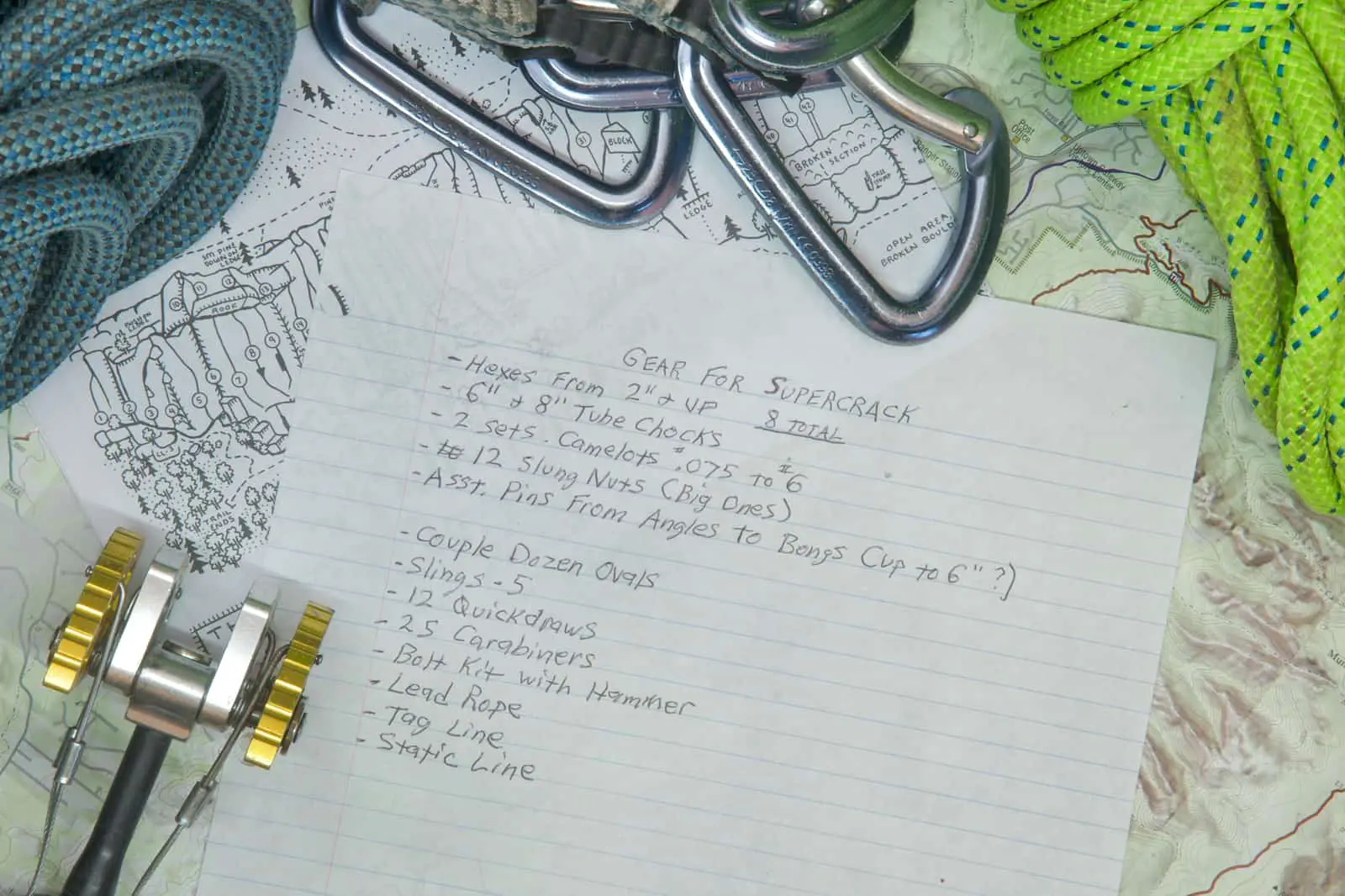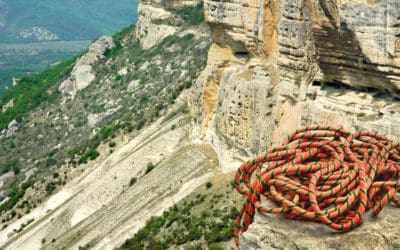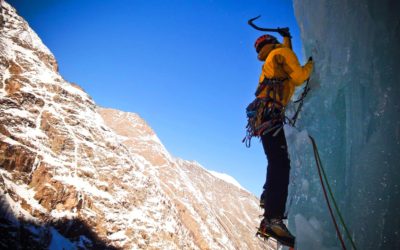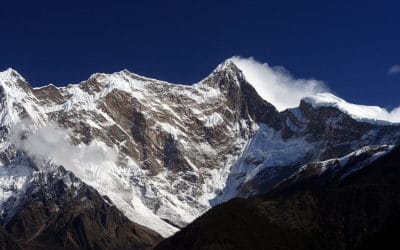
When you’re traveling for a climb, especially internationally, you have to keep track of what gear you can and can’t pack for your trip, what’s allowed in hand luggage, what you can put in checked luggage and what gear you should declare before you go.
In short, these climbing gear pieces are best checked in or left at home:
- Ice climbing gear (crampons, axes)
- Propane canisters (cooking stoves)
- Trad gear (could work but high risk)
I aim to answer this question more in detail down below, along with giving some tips for international climbing travel.
Chalk bag top tip
A quick tip on chalk bags: it’s better to leave your chalk in the actual chalk bag with the drawstring pulled as tight as it could go, rather than putting your chalk in a Ziploc bag.
A plastic bag filled with white powder looks seriously suspicious and could put you in line to get to know the TSA agents a bit better. Not fun at all.
What to Pack Where
Trad gear (traditional climbing gear) is best checked in, since airport officials are generally a bit nervous about this. You definitely don’t want your precious gear confiscated, especially not on the way to your awesome climb or trek.
Ice climbing gear also resemble weapons, so you’ll definitely have to check those.
Sports climbing gear, like chalk bags, harnesses, helmets and climbing shoes are generally fine in your carry-on bag. They’ll probably be safer there too, if you’re worried about stuff being stolen from your bag.
Crash pads for bouldering can go as checked luggage, though you will probably pay for them as a separate bag. Sometimes, it’s more economical to buy a crash pad at your destination, then leaving it there or reselling it.
Anything that could potentially explode, like propane canisters or white gas for your little cooking stove, are definitely not allowed, even in checked baggage. Those ones, you’ll have to purchase on arrival, unfortunately.
If you’re not sure about a specific airline’s policies, just give them a call before you go, making sure that you don’t pack anything iffy in your carry-on bag.
Pack Light
You don’t need a ton of stuff on a trip and you definitely don’t want to lug a lot of stuff with you wherever you go. Taking a lot of stuff puts you at risk of incurring extra charges for baggage as well. For this reason, it’s best to fit all your stuff into two bags – one checked luggage and one carry-on.
For many climbing trips, I usually pack the absolute minimum and instead try to manage so that I can rent equipment on site. I try to pack what I find to be most important and non replaceable, such as mountaineering boots.
This list of items will be different for everybody. Just ask yourself: what gear item, if rented on site, would clearly not be of same quality as my own item?
Seal Liquids
The decreased cabin pressure you encounter up in the air makes all your liquid stuff expand. This could cause a serious mess in your bag, getting all your precious gear and clothes covered in shampoo or body wash.
Here, you have a few options, like packing each bottle in its own Ziploc bag, or taping duct tape over the lids to prevent them from coming off.
You can also unscrew the caps, place a piece of plastic over the mouth of the bottle and screw the cap back on. Or check out the internet for more ideas.
The moral of the story is, liquids are messy, so seal them before you go.
Jet Lag when Climbing
Try to sync up with your destination’s time zone just before you leave. Jet lag sucks, especially if you want to send a route with limited time and you’re body’s stuck in the wrong time zone.
If you will be doing technical climbing at your destination and there is a severe time difference, it is always a good idea to schedule your flight a couple of days earlier than otherwise. You don’t want to make a mistake causing someone or yourself to get hurt by simply being jet lagged.
Take the time zone of your destination into account when you’re planning on whether or not to sleep on a flight. If it’s day time there while you’re travelling, try to stay awake. The converse is also true.
Some people are in favor of using sleep aids in the plane in order to help you sleep and be awake at the right times. This is up for debate, though, since some people don’t agree with this method at all. Find what works well for you and stick to that.
It’s also a good idea to avoid caffeinated drinks during your travel time, since these cause dehydration, worsening the effects of jet lag. Hand-in-hand with that, you should remember to drink lots of water and take vitamins. This will help you stay hydrated and healthy, enabling you to enjoy your trip even more.
In-Flight Meals
On some airlines, you can request alternative in-flight meals ahead of time through their website. Here, you can avoid the standard, pasta and cream sauce, meal if that doesn’t float your boat.
This also helps if you’re aiming for meet-free or dairy-free options. Be aware that this sometimes comes with extra costs.
Conclusion
Most airlines are fine with climbing gear, as long as the gear that resembles weapons is placed in your checked luggage. The only thing you should definitely not take with you, is propane canisters or white gas for cooking.
Before you go, make sure that you know the baggage limitations set by your airline of choice. Also pack light to avoid incurring extra costs for your baggage.

Written by Felix
April 21, 2019

About me
Hi! I’m Felix. When I’m not spending time out in the mountains, I like to write about my hobbies. That is how Mountain Homies was created. On this site, I try to gather all the juicy information about Mountaineering that I have learned since I started. Happy adventures!
Recent Posts
5 Ways of Knowing If Your Climbing Shoes Are Too Big
It has almost become a prestige among climbers to be able to boast about how small and tight climbing shoes can be used. There is therefore a lot of talk…
Mountain Climbing vs Rock Climbing: 5 Biggest Differences
The key differences between rock climbing and mountain climbing are the gear requirements, environmental risk, geographical locations, weather and…
Rock Climbing vs Ice Climbing: Everything You Need To Know
In summary, In Ice climbing you need more equipment and falling is more dangerous than in rock climbing. Routes on ice and rock have…
Related Articles
Mountain Climbing vs Rock Climbing: 5 Biggest Differences
The key differences between rock climbing and mountain climbing are the gear requirements, environmental risk, geographical locations, weather and…
Rock Climbing vs Ice Climbing: Everything You Need To Know
In summary, In Ice climbing you need more equipment and falling is more dangerous than in rock climbing. Routes on ice and rock have…
World’s 11 Highest Unclimbed Mountains
Unclimbed peaks are often referred to as Virgin peaks. Many of these peaks are considered to be tougher and more difficult than Everest. Furthermore, the mountains…
Stay Up to Date With The Latest News & Updates
Join Our Newsletter
The owner of this site is a participant in the Amazon Services LLC Associates Program, an affiliate advertising program designed to provide a means for sites to earn advertising fees by advertising and linking to amazon.com.




